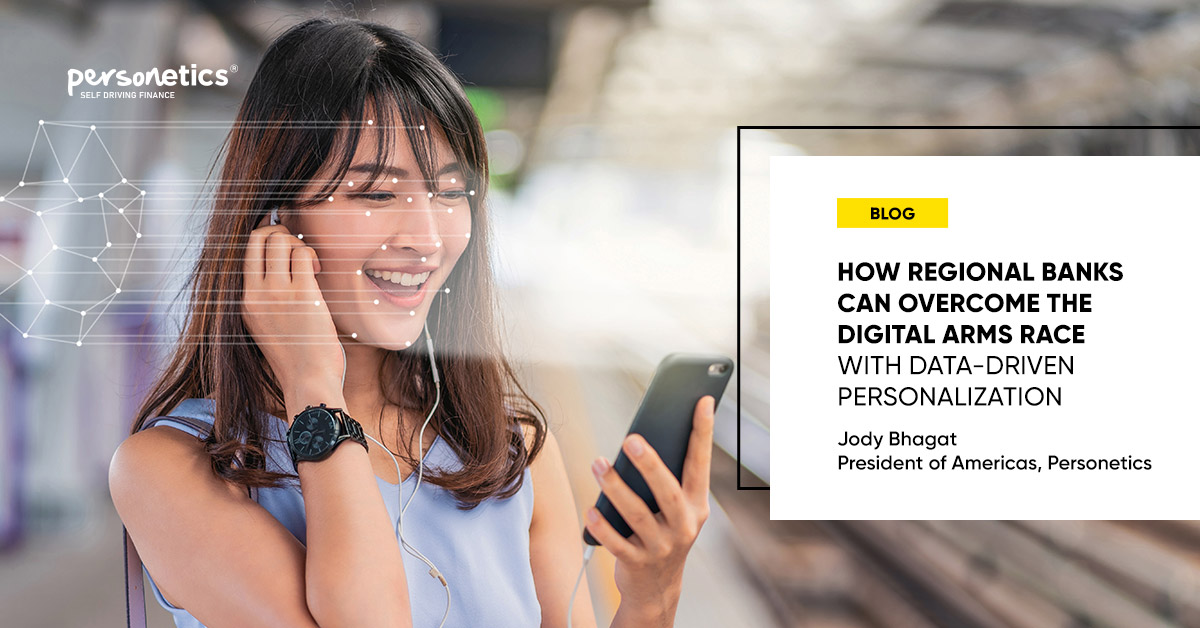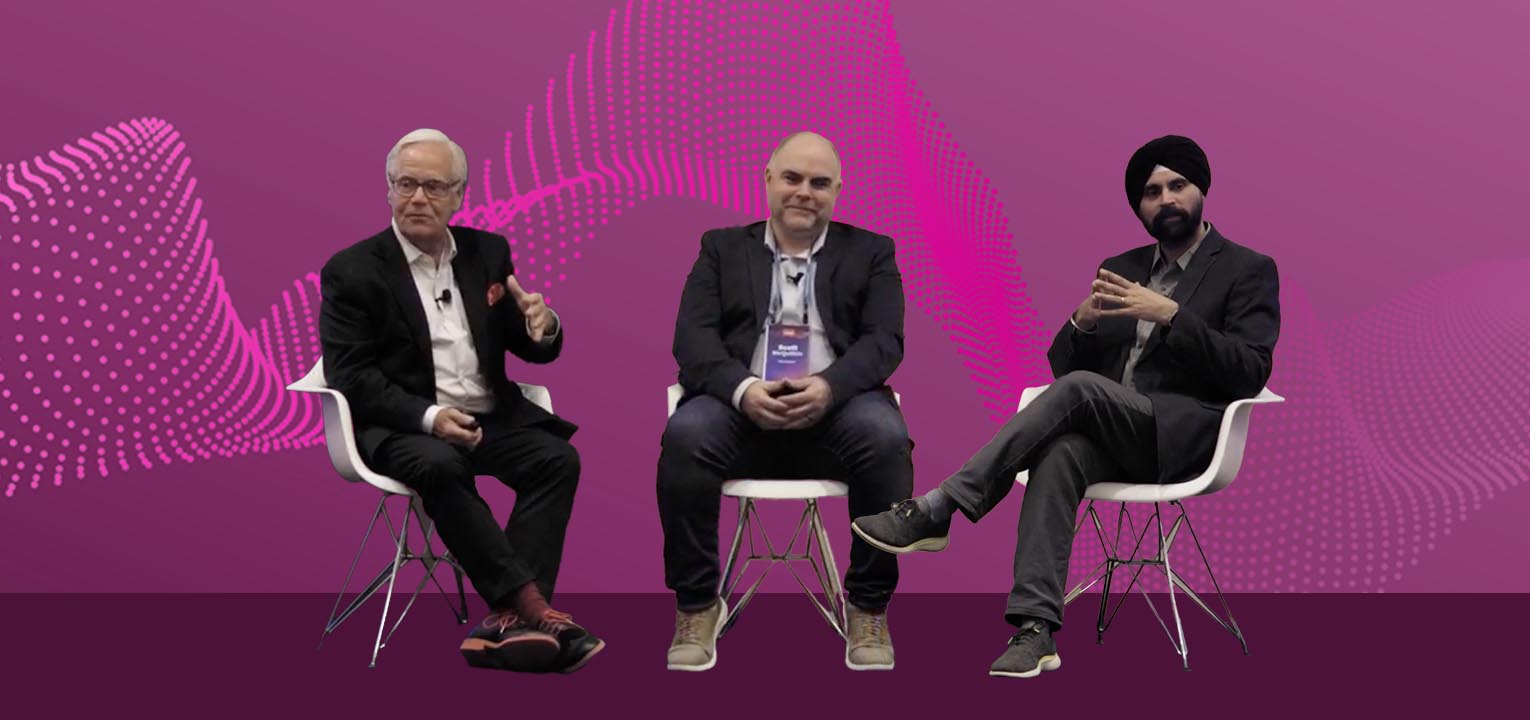February 10, 2022
How Regional Banks Can Overcome the Digital Arms Race With Data-Driven Personalization

Regional banks face intensifying competition from big national banks, challenger banks, and technology firms to meet banking needs. While making the right digital investments is vital to compete, it can feel like a digital arms race with a myriad of digital technologies to decipher. Rather than chasing features to stay at parity, regional and community banks should focus on selective digital investments that differentiate their experience. The experience should be tailored for their customers and amplify their product and service value.
I’d like to share a preview of some of the key points from my presentation, giving a broad overview of data-driven personalization and why it matters more than ever for regional and community banks.
What is Data-Driven Personalization and Self-Driving Finance?
Personetics is a global leader in data-driven personalization. Our vision is one of Self-Driving Finance where banks proactively act on behalf of customers to better monetize relationship value. We analyze transaction data to deliver personalized interactions and advice in real-time to drive business impact.
Customers have many jobs to be done in their financial lives: saving for a goal, paying down debt, growing wealth, or making a big purchase. We believe that the customer’s primary bank is in the best position to deliver on these customer needs. Data-driven personalization can help banks get better visibility into the customer’s finances, identify insights, recommend products, and deliver value-added financial advice at the right moments in the customer journey.
Why Regional Banks Need Data-Driven Personalization
Regional banks are operating in an environment of rising competition:
- Trillion-dollar national banks are capturing 51% of new checking customers.
- Challenger banks are attracting 15% of customers who are new to the banking industry.
- Wealth companies are expanding into banking services.
- Retail and big tech companies are using banking-as-a-service to introduce new distribution points to address customer needs.
I recently met with a dozen CIOs and chief digital officers at an executive round table on open banking. There was wide agreement that open banking and the transition to open finance are going to exacerbate the intensity of competition by creating greater transparency around pricing, and ease of data sharing.
The outcome from all these developments is likely to be a greater disparity in performance between banking leaders and banking laggards. Regional banks and community banks risk getting stuck in an uncomfortable middle ground in the market, where they feel too small to invest aggressively in digital technology like the big banks but are also too big and established to innovate and be agile like the challenger banks.
We’re already seeing a dramatic shift in customer behavior: almost 70% of financial transactions are performed through digital channels. Legacy tech stacks can hold back the degree of innovation for some banks. We’re likely to see greater churn and margin compression. Finally, as more competitors embrace banking-as-a-service and embedded finance, the new distribution points for customer engagement will further intensify competition to deliver on these banking needs.
How can regional and community banks compete in this new landscape? By doing more of what they do best: focusing on their customer relationships. Even with all these changes and digital shifts, there are a set of enduring customer expectations that continue to prevail in banking: Know Me, Value Me, Advise Me.
The challenge for regional banks: evolve their local relationship-based banking model to deliver with excellence for these customer expectations. Data-driven personalization is becoming essential to make this possible.
Data-Driven Personalization: The New Competitive Battleground
Data-driven personalization is the new basis for competition for community and regional banks. The process of adopting personalization involves several stages:
- Cleansing and enriching transaction data to deliver personalized insights and advice.
- Delivering personalized journeys for the jobs to be done in the customer’s financial life, with insights, offers, and advice.
- Creating Connected Channels, to enable a blended experience across channels throughout the bank, and proactively engage customers based on the most appropriate channel of interaction.
A recent Personetics study found that 55% of the top 40 North American banks have either implemented or are in the process of implementing personalized insights and advice. I believe that basic personalized insights and advice will be table stakes, and will be offered by all banks by the end of 2023. If it’s not in your budget for 2022, it will likely be for 2023.
More importantly, this capability is not just about regional banks achieving parity with the big national banks, and it’s not about falling into a never-ending arms race for digital features. Data-driven personalization will be a battleground to differentiate regional banks, by helping those banks further their brand promise and go deeper into their local customer relationships, creating a virtuous customer “flywheel” which focuses on increasing Customer Lifetime Value.
How Data-Driven Personalization Works
Let’s take a closer look at how personalization really works in everyday banking. Personetics has the most robust library of insights globally, more advanced than any bank; we offer 11 categories and more than 300 insights, such as:
- Identifying duplicate transaction charges
- Change in payment activity
- Identifying when a customer is better suited to another product
- Noticing when a customer might have a low balance issue in the future, in advance of their next expected deposit
These insights and interactions can be delivered proactively to help customers manage their daily banking.
Protecting Customers With Data Privacy and Controls
It’s also important to understand that data privacy and operational controls are a central focus of data-driven personalization strategies. Open banking does not mean “unprotected bank customers;” these capabilities are not just about sharing customer data, they’re about managing and protecting customer data with a strong foundation of regulatory compliance and data privacy.
For self-driving finance and open banking to fulfill their potential, they need to have strong privacy protections and operational controls, including:
- Structured data environment for ease of sharing and managing access
- Simplify and provide transparent customer consent
- Full compliance with GDPR and “Right to be forgotten”
- Customers can Opt In to automated programs, with the option to pause or cancel at any time
- Help customers by protecting them from overdrafts – along with encouraging proactive moves to improve the customer’s financial wellness, data-driven personalization can help protect customers from negative impacts to their finances
The same organizations that are most enthusiastic about adopting open banking and data-driven personalization also tend to take a proactive approach to compliance and risk. When banks have a strong foundation of data security and prudent controls, they can be empowered to innovate.
Which Banks are Leaders in Data-Driven Personalization?
Forward-leaning banks are already showing results with data-driven personalization:
- In October, I participated in a Bank CEO event where Bank of America’s CEO, Brian Moynihan, spoke about the remarkable results in adoption and usage the bank is achieving with personalized insights for its Erica® platform, which provides virtual financial assistant support within the mobile app.
- S. Bank’s mobile app and mobile experience tied for #1 out of 17 banks on the Q3 2021 Keynova Mobile Banker Scorecard, which highlighted the bank’s proactive insights and guidance to help improve customers’ financial health.
- Several years ago Huntington Bank would have been considered a branch-based high performer, but they have been recognized by the Financial Brand as quietly becoming a digital powerhouse and were recently voted #1 regional bank in the J.D. Power U.S. Banking Mobile App Satisfaction Study for the third year in a row. Digital advancements include the Huntington Heads Up® (real-time insights on spending and savings) and Money Scout® for automated savings.
- DBS in Singapore has won accolades as “World’s Best Digital Bank” and “Asia’s Best Digital Bank” for 2021. They have branded their Digibank app experience “effortless banking” to drive new organic customer acquisition growth.
- KBC in Belgium has achieved 90% customer satisfaction rate with insights and 35% active monthly engagement.
Not all banks have the same technology and budget as a big bank, but every bank can benefit from using an external platform to achieve scale and efficiency, and then spend their internal analytics resources on creating custom insights and interactions tailored to their unique customer base and offerings.
Next Level of Personalization: Journey Enablement
Beyond delivering personalized interactions, the second stage is journey enablement, by combining personalized insights and offers. This capability can help banks engage with customers at the exact moment of a person’s financial life where they need advice, a new financial product, a loan, and more.
Here are a few example scenarios of how this can work in everyday banking situations:
New Baby on the Way
A bank customer has shown increased income deposits, excess liquidity in checking, and is starting to make purchases at a baby store. We can offer proactive advice and offers to help that customer save for a goal, such as saving for a child’s education. Banks can offer insights on how much the customer can afford to save at any given time, or use an intelligent automated savings program, since the program understands the customer’s cash flow and can help them save without incurring a balance issue.
Managing Debt
Data-driven personalization can also help banks recognize when a customer’s external debt is increasing, when the customer is starting to revolve debt, and when the customer does not have an internal loan product with their bank.
For customers in this situation, the bank can proactively offer the customer a debt consolidation loan to save on interest payments, and offer an automated program to do a debt paydown, by asking the customer which debt they want to pay off. The algorithm will help move money when the customer has the capacity to do so, like an automated savings program, but focused on paying down the debt.
Imagine how much more appreciation and loyalty customers will have for their primary bank, when the bank can proactively help them manage their debt.
Connected Channels for Unified Advice
The ultimate stage of data-driven personalization is what we call “Connected Channels,” to help the various departments and channels of the bank stay on the same page, see the same information, and speak in a unified voice to help the customer.
Let’s say the bank has a customer where, from the transaction data, we recognize a disproportionate spend at home improvement merchants, like Home Depot or Lowe’s. The customer also has an external mortgage, and a high level of branch visits; they’re likely to visit the branch for routine transactions.
In the digital channel, we will show the customer personalized insights with home improvement content, and encourage them to set up an appointment with a banker. In parallel, we can also provide intelligence to the banker, so they can be well informed and have a proactive conversation with the customer to talk about the customer’s needs. We can also push this data to the marketing stack, to improve customer segmentation and marketing campaign performance.
All of this information can be retrieved from transaction data which typically resides insides the bank. Personalization will become even more powerful as open finance becomes more fully embraced. But the key is to have a platform to cleanse, enrich data, run the machine learning models that identify what’s most important for the customer to be aware of, and to act on, and deliver it in a proactive way.
Higher Visibility into Customer Finances, Better Banker Productivity
Data-driven personalization not only offers personalized interactions and automated programs, but it provides bankers with a financial activity map that aggregates transactions into a portfolio that shows significant events and opportunities at the customer level. In portfolio view, you can see loan amounts that are held at the bank vs. external, and see which competitors are seeing increases or declines in share. At the customer level, you can recommend a home improvement loan based on transaction activity that we recognize; we call this “Customer Enrichment.”
In an environment where banks are cutting branches, this can help improve banker productivity and drive a greater depth of relationship with customers. We’re only in the initial stages but we’re already seeing strong results, with much more to come. Our clients are seeing 25-40% of customers engage on a monthly basis, higher digital sales rates, much better customer satisfaction, and demonstrably better customer retention for customers that engage with the personalized interactions.
Data-driven personalization can create a positive flywheel: driving higher engagement, stronger sales, increased banker and marketing productivity, and then can be extended from the consumer side to SMB digital banking and wealth. Regional banks don’t have to get into a digital features arms race. Instead, focus on capabilities that can differentiate the way you interact with customers. Leverage data-driven personalization to deliver proactive and intelligent interactions, cost-effectively, at scale; so customers can accomplish their jobs to be done. This will accomplish a strong business impact and a loyal customer franchise.
Ready to learn more? Watch Jody Bhagat’s presentation at the American Banker Digital Banking Virtual Summit.
Want To See How Cognitive Banking and AI Can Transform Customer Engagement?
Request a Demo Now
Latest Posts

Truist's Performance Marketing Journey: From Merger Challenges to Million-Dollar Results

How Asia Pacific Banks Are Redefining AI-Driven Engagement

How iBank and Personetics are Transforming Personal Finance in Japan

Beyond Transactions: How Synovus is Creating Deeper Digital Engagement at Scale

4.5 Stars and 20% CTR: How BGL BNP Paribas’s Genius is Reinventing Digital Banking

The AI Implementation Reality Check

Jody Bhagat
President of Americas
Jody brings deep operating experience in financial services – managing direct channels, launching digital ventures, and leading digital transformation programs. He was previously a Partner at McKinsey & Company, where he helped financial institutions define and execute digital transformation programs to drive customer growth and operating efficiency. Jody also served in senior digital operating roles at U.S. Bank, Wells Fargo, and Providian. In these positions, he led digital sales and service functions and direct-to-consumer businesses to deliver organic growth and enhanced customer experience. Jody has an MBA from Northwestern University and a BS in Computer Engineering from The University of Michigan.









